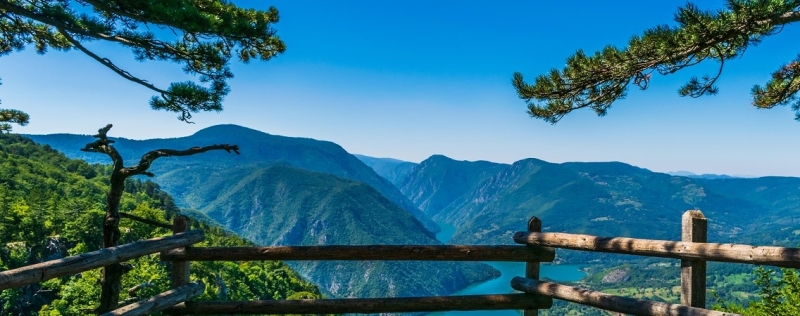
If you want to go to Europe, which is accessible to Russians today, pay attention to these countries: COVID documents and visas are not needed for entry, and you can get there from Moscow without transfers. The Balkan Peninsula pleases with its mild climate, hospitality and friendliness: they will try to help you, even if you don’t know the language at all and explain yourself on your own. However, moving around the Balkans by public transport is a frequent pain point for tourists. Bank cards are not accepted everywhere, and the bus may not arrive at all. We tell you how to plan a trip to Serbia and Bosnia and Herzegovina and save your nerves.
Serbia
Entry rules
Russians will only need a foreign passport to visit the country. For a tourist trip up to 30 days, a visa is not required. The local currency is the Serbian dinar, 1 RSD is equal to approximately 0.63 rubles. Cards issued in Russia do not work in the country, use cash or cards from other countries.
How to get there
You can fly from Moscow to Belgrade on a direct AirSerbia flight. The flight takes 3 hours, and one-way tickets cost from 38,000 rubles*. It is cheaper to fly with a transfer in Istanbul or Ankara.
Where to stay
Good People Design Hostel (rating 9.2) –– from 3,200 rubles* per night.
Dominic Smart & Luxury Suites — Parliament (score 9.6) –– from 7,500 rubles* per day.
SAINT TEN Hotel (rating 9.5) –– from 12,000 rubles* per night.
Square Nine Hotel Belgrade (rating 9.5) ––from 20,000 rubles* per night.
Day 1. Belgrade
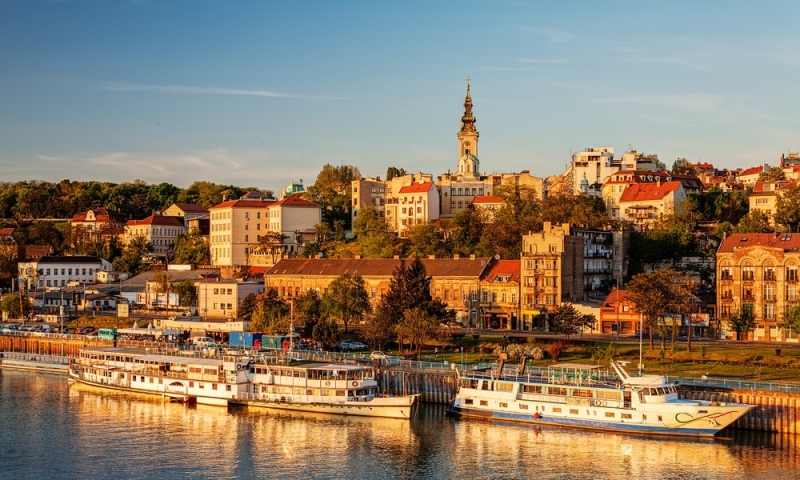
You should start your journey from the center of Belgrade. The main street of the city is Freedom Square, near which you will see the Catholic Cathedral of the Virgin Mary, this is the tallest building in the country. Nearby is the National Museum, where you can listen to the history of the Balkan Peninsula. It also houses several original works by Van Gogh, Matisse, Kandinsky and Rembrandt. The ticket costs 200 RSD (approximately 125 rubles*), and can only be paid in cash. On Sunday admission is free, but on this day the museum closes at 14:00.
The cultural program ends with the Nikola Tesla Museum. There are only three rooms inside; if you know English, you can take a tour with practical experiments. A ticket in English costs 800 RSD (approximately 500 rubles*), in Serbian it is half the price.
In the evening it is worth taking a walk to the historic district of Scardalia. It is located near the old town. There are many antique shops and good restaurants, and there are often street exhibitions of local artists.
Day 2. Golubac Fortress
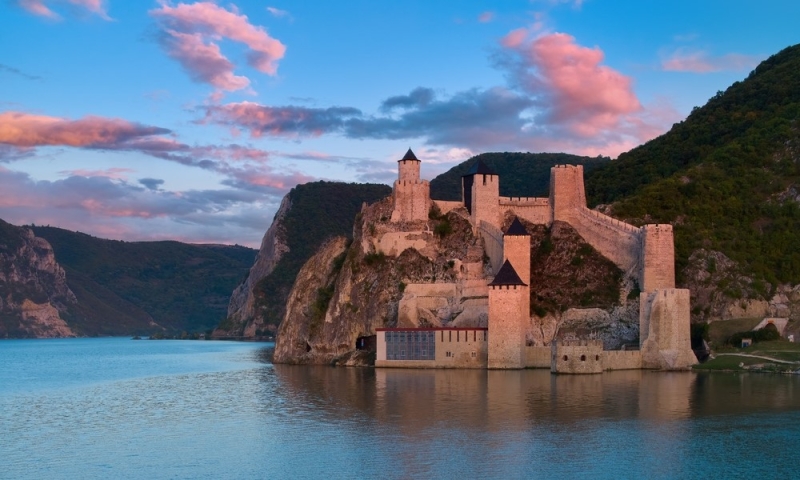
On the second day we suggest going to explore the Golubac Fortress, built in the rocks on the banks of the Danube. It offers a breathtaking view of the “Iron Gate” – the place at the entrance to the Djerdap Gorge, where the Danube narrows from 6 km to 162 m.
A bus runs from Belgrade to Golubac 3-5 times a day, depending on the season. To visit the fortress, it is better not to get off in Golubac itself, but at the next stop Dedine, so there is less walking. Entrance is paid and depends on the chosen route. There are four of them, differing in the level of complexity and the number of structures visited. The route costs from 650 to 1500 RSD (400-950 rubles).
Day 3. Nish
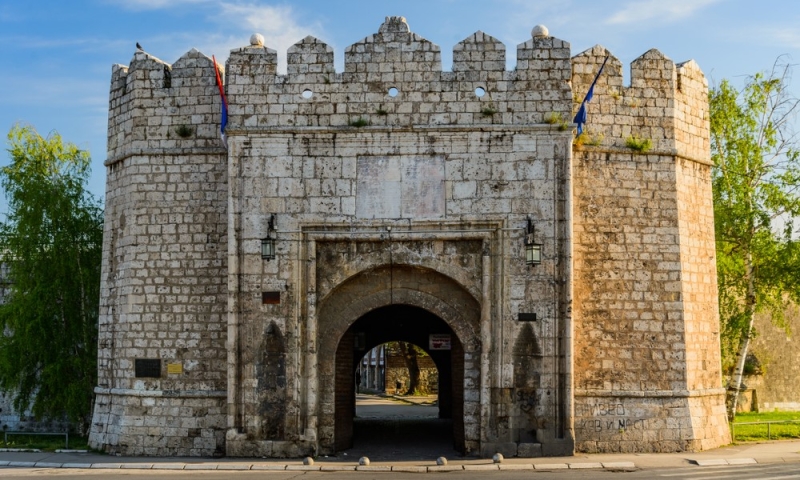
This is one of the three large cities in Serbia that can be reached from Belgrade by bus in three hours. A round-trip ticket costs from 1995 RSD (from approximately 1,300 rubles*).
In the city center, see the old fortress and mosque of Bali Bega from the 16th century; only some fragments have survived to this day. It’s worth going to Nis to visit the Crveni Krst concentration camp. All buildings have been preserved on the territory; inside there are three museums, various exhibitions and a memorial.
Upon returning to Belgrade, pack your bags, tomorrow you will be moving to another city without a return ticket.
Day 4. Novi Sad
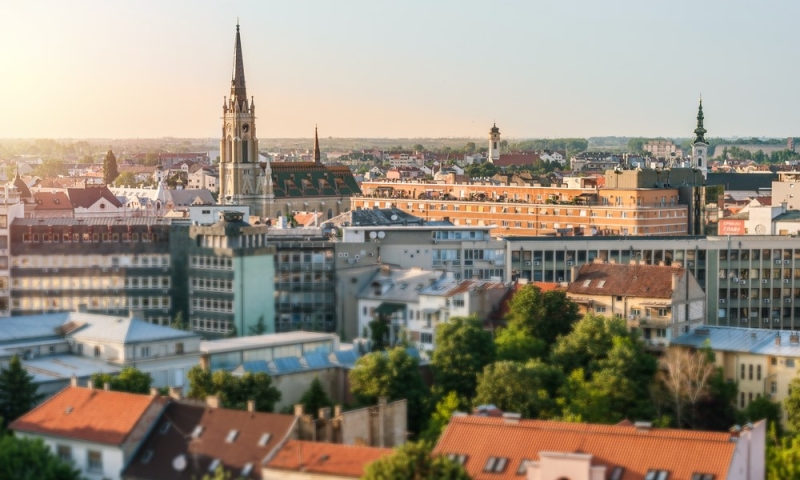
Novi Sad, Serbia’s second largest city, can be reached from Belgrade in an hour and a half by bus. A one-way fare starts from 820 RSD (550 rubles*). It’s worth staying here for two days: the first to explore the city, and the second to go to the national park.
Where to stay
Manoir Apartments Novi Sad (rating 9.6) –– from 3 100 rubles* per day.
Garni Hotel Leopold I (rating 8.9) –– from 5,300 rubles* per night.
Guest House Panorama Aqualux (rating 9.3) –– from 6,000 rubles* per night.
Leo Tolstoy once lived in this city, and there are also two officially shortest streets – Nenada and Velikovicha. Their length is only 31 m. The main pedestrian and most beautiful street of the city is Danube. Here you can not only find a good cafe or souvenir shop, but also get a feel for how local life is in full swing. The street leads to Freedom Square, where, like in Belgrade, there is a tall Catholic cathedral. You can get acquainted with the history of the city at the Vojvodina Museum or go to the Petrovaradin Fortress.
20 km from Novi Sad is the Fruska Gora National Park. The territory contains many ancient monasteries, springs, lakes, hiking trails and observation platforms. In the park you can see deer, weasel, squirrel and even a rare black stork. Fruska Gora is open 24 hours a day, tourist centers are open until 18:00. It’s better to spend a whole day visiting the park, and in the warm season you can even spend the night here with a tent.
From Novi Sad it is easy to get to different parts of the park by buses No. 72, 72, 78, 61 and 62. You should always go to the end, and then walk a little.
Day 5. Ethnic village and Mokra Gora National Park
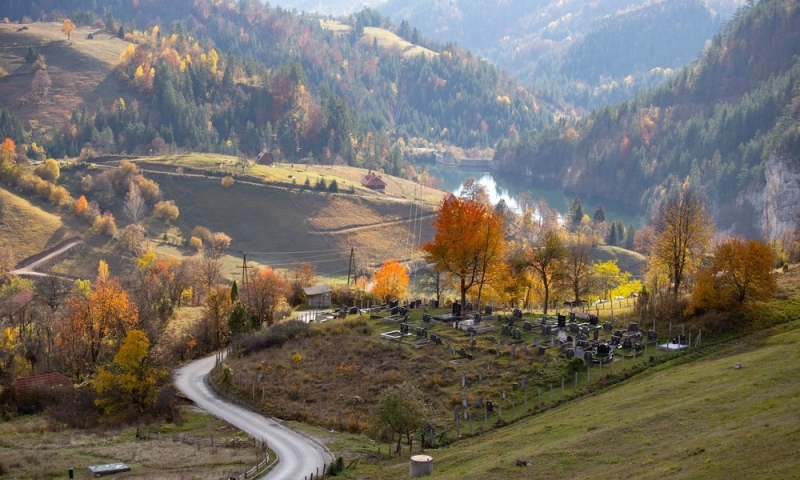
On the border with Bosnia and Herzegovina there are two Serbian national parks – Mokra Gora and Tara. In the first one, for the film “Life is a Miracle” by Emir Kusturica, the entire ethno-village of Mečavnik, or Drvengrad, was built without a single nail—even the streets were lined with wooden paving stones. The scenery turned out to be outstanding; now behind it lies a hotel complex with restaurants, shops and an underground cinema. After getting acquainted with Serbian life, you can relax while watching a movie or going to the spa. Entrance to Drvengrad is paid, but the price changes periodically – it costs from 100 to 250 RSD (60-160 rubles*).
If you are traveling to Drvengrad from April to October, be sure to buy a ticket for the ancient Shagran Eight railway. The train takes tourists around the picturesque surroundings on a circular route. The entertainment costs 900 RSD (550 rubles*). Payment only in cash.
Mečavnik is not easy to get to. The journey takes five hours. There is only one direct route – a bus leaves from Belgrade to Sarajevo and passes through Mokra Gora. But he doesn’t have a schedule or number; you need to check in advance at the bus station.
You can also get there with a transfer in Uzice – buses leave from the bus station every hour and an hour and a half, check the exact schedule and ticket price at the ticket office. It will cost about 1,000 RSD (600 rubles*). From Užica to Mokra Gora there are minibuses or passing buses to Sarajevo; you should also check their schedule at the bus station. If you don’t like adventure, you can get there by taxi, but it will be more expensive.
Day 6. Tara National Park
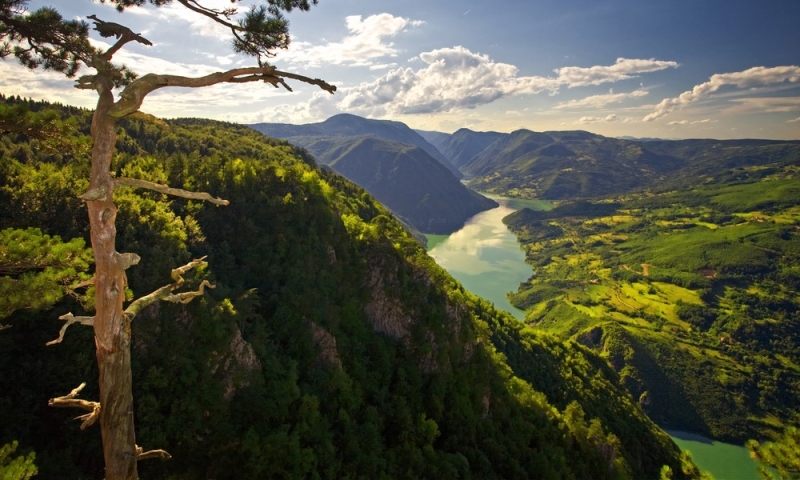
A real natural pearl of Serbia and an ideal place for hiking. There are about 300 km of walking trails, 4 cycling routes and paved car paths on the territory. The visitor center offers bicycle rentals and luggage storage. You can also sign up to watch wild bears here.
To get to Tara, you need to return to Uzice and take a bus to the city of Bajina Basta – the journey takes an hour and costs about 150 RSD (100 rubles *). From there there are minibuses to the village of Mitrovac – choose any one. The drive takes no more than 30 minutes, but minibuses may run rarely – in this case a taxi will help out. An entrance ticket to the park costs about 300 RSD (200 rubles*), depending on the season, the price may vary.
Where to stay near the park
Garni Hotel Vila Drina (rating 8.6) –– from 2,900 rubles* per night.
Zepter Hotel Drina Bajina Bašta (rating 8.6) ––& nbsp;from 3,300 rubles* per day.
Bosnia and Herzegovina
Entry rules
Russians will need a foreign passport valid for at least three months from the end of the trip. For a tourist trip of no more than 30 days, a visa is not required. The local currency is the convertible mark, 1 BAM is approximately equal to 38 rubles. Russian bank cards do not work in the country, use cash or foreign cards.
How to get there
From Serbia it is convenient to travel from Belgrade, but on our route the fastest way is from Tara Park, which is located near the border with Bosnia. From Bajina Basta, take the bus to Mali Zvornik.
Where to stay
Hotel Grad (rating 9.0) –– from 4,000 rubles* per night.
Ibis Styles Sarajevo (rating 8.8) –– from 5,800 rubles *per night.
Novotel Sarajevo Bristol (rating 8.7) –– from 7,300 rubles* per night.
Day 7. Sarajevo and Ilidza resort
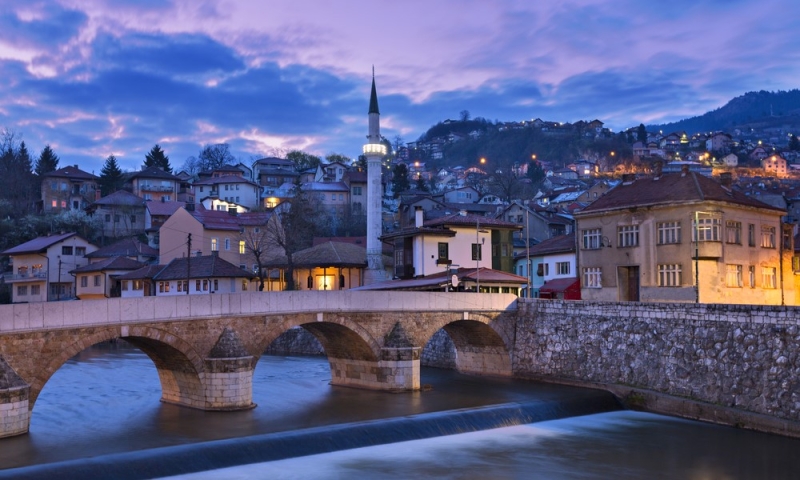
The most convenient way to explore the capital is by taking tram number 3. Its route runs through the entire city: from the old Baščarija bazaar to the province of Ilidzha. The journey will take about 30 minutes. A ticket for one trip costs 1.6-1.8 BAM (about 50 rubles*), you can buy it at a kiosk at the bus stop or from the driver. An unlimited day pass will allow you to get off at any stop and walk around the capital’s districts. It costs 5.3 BAM (about 200 rubles*).
The Ilidza resort is a complex of outdoor thermal pools; the entrance ticket costs 7 BAM on weekdays and 9 BAM on weekends (about 260 and 350 rubles*). Renting an umbrella and sun lounger costs 6 BAM (230 rubles*), a locker costs 5 BAM (190 rubles*).
Day 8. Mostar
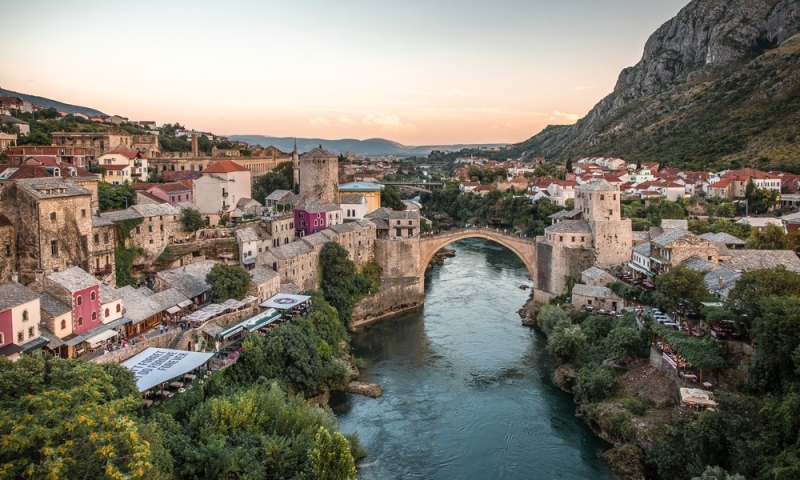
Here is one of the iconic sights of Bosnia and Herzegovina – the old bridge, after which the city was named. Mostar is small, so you can walk around all the central streets and drink strong coffee in a couple of hours. It takes two hours to get to Mostar by train, the ticket costs from 14 BAM (about 530 rubles*).
Where to stay
Sinan Han Motel (rating 9.2) — from 3,800 rubles* per night.
Hotel Pasha (rating 9.5) – from 5,700 rubles* per night.
Apartment Light De Luxe (rating 9.3) – from 7,000 rubles * per night.
13 km from Mostar is the city of Blagaj, the former capital of Bosnia and Herzegovina. The Blagajska Tekkia monastery stands in the rock near the blue source of the Buna River. It was built at the beginning of the 16th century and is still in use. You can go inside for 4 BAM (about 150 rubles*). From Mostar, from Španski Trg Square (the yellow university building is the landmark) to Blagaj there are buses No. 10, 11 and 12. The driver’s ticket costs 2.10 BAM (about 80 rubles*), the journey takes no more than half an hour. It will be easier to get there by taxi. Ask the driver to turn on the meter before departure: boarding costs 3 BAM and another 1 BAM for each km. A trip to Blagay will cost approximately 16 BAM (about 600 rubles*).
Day 9. Kravice Waterfalls
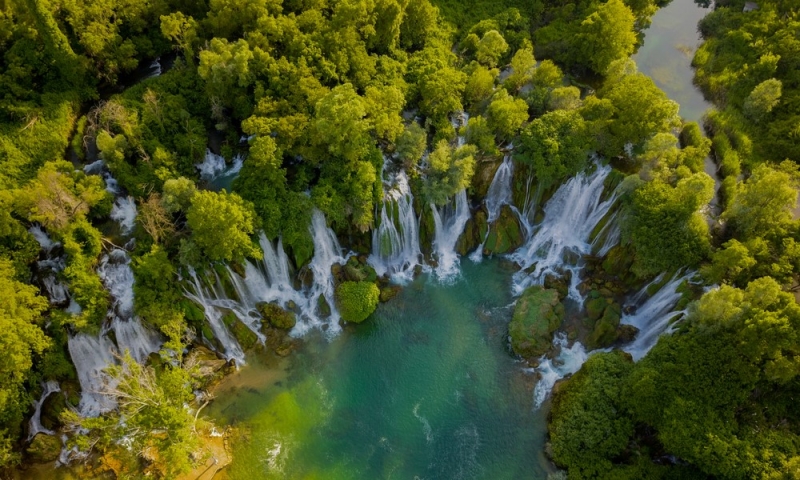
The main natural attraction of the country is a cascade of 20 Kravice waterfalls, 25 m high. They are surrounded by greenery and fall into a pool, as if created for swimming. The park has canoe rentals, hiking trails, camping and a café. The entrance ticket costs from 10 to 20 BAM depending on the season (about 380–760 rubles*), the ticket office closes at 18:00.
From Mostar you need to take a bus to the towns of Ljubuski or Chaplina – from them to the park is about 10 km. You can take a taxi or walk. An alternative is the train, which leaves at 9:12 am, the journey takes 25 minutes. A one-way ticket costs 6 BAM (about 230 rubles*).
Coming home
The return trip can be planned in different ways. The first option is to take a train from Chaplina to Sarajevo (the last one leaves at 19:49, the journey takes about 2.5 hours), the ticket costs 17 BAM (650 rubles*). From there, planes fly to Russia with a transfer in Istanbul, tickets cost from 14,500 rubles*.
The second option is to travel from Sarajevo to Belgrade and return to Moscow on a direct flight. The flight with Air Serbia lasts 3 hours, the ticket costs from 47,500 rubles*. To the border with Serbia, take the bus to Zvornik, just like you came to Bosnia, from there take the bus to Belgrade. The fare costs 1,140 RSD (about 700 rubles*), the journey takes 3.5 hours. You can take the same bus at Sarajevo airport, from there it takes 8 hours to get to Belgrade, the ticket costs 2,340 RSD (about 1,500 rubles*).
*Prices are current at the time of publication
Convenient hotel search engine – OneTwoTrip.

